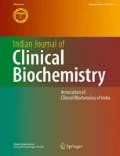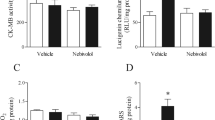Abstract
In this communication, we show the modulatory potential of papaverine, an opium alkaloid and a well known vasodilator agent on the ethanol-induced hepatic oxidative stress in male Wistar rats. Ethanol treatment (50% v/v) enhanced lipid peroxidation significantly accompanied by a decline in the activities of glutathione peroxidase (G-Px), glutathione reductase (GR) and depletion in levels of hepatic glutathione (GSH). Ethanol administration increased hepatic glutathione-s-transferases (GST). Enhanced lipid peroxidation induced by ethanol was significantly reduced when papverine was coadministered (P<0.05). In addition, the depleted levels of glutathione and inhibited activities of G-Px and GR recovered significantly (P<0.05) levelling off to control values on co-exposure. Papaverine (200 mg/kg bw) effectively antagonised the ethanol-induced lipid peroxidation and impaired glutathione levels and glutathione dependent enzyme systems. Our results suggest that papaverine is an effective chemopreventive agent in the liver and may suppress the ethanol-induced hepatotoxicity.
Similar content being viewed by others
References
Plaa, G.L. and Witschi, H. (1971) Chemicals drugs and lipid peroxidation Annu. Rev. Pharmacol. Toxicol. 16, 125–141.
Irving, M.G., Halliday, J.W. and Dowell, L.W. (1988) Association between alcoholism and increased hepatic iron stores. Alcoholism Clin. Exp. 12, 7–13.
Chance, B., Sies, H. and Boveris, A., (1979) Hydroperoxide metabolism in mammalian organs Physiol. Rev., 59, 527–605.
Sies, A., Wendel, A. and Bors, W. (1984) In: Metabolic Basis of Detoxification, Ed. Jakoby, W.B., Bend, J.R. and Caldwell, J. Academic Press, New York, Vol. 2, p. 307.
Flohe, L. (1982) In: Free Radicals in Biology, Ed. Pryor, W.A. Academic Press, New York, Vol. 5, p. 223.
Jakoby, W.B. and Habig, W.H. (1980) In: Enzymatic Basis of Detoxification, Ed. Jakoby, W.B., Academic Press, New York, Vol. 2, p. 63.
Farooqui, M.Y.H. and Ahmed, A.E. (1984) Circadian periodicity of tissue glutathione and its relationship with lipid peroxidation in rats. Life Sci. 34, 2413–2418.
Minor, T. and Isselhard, W. (1993) Role of the hepato vasculature in free radical mediated reperfusion damage of the liver. Eur Surg. Res. 25(5), 287–293.
Shiraishi, N., Arima, T., Aono, K., Inouye, B., Morimoto, Y. and Utsumi, K. (1980) Inhibition by biscoclaurine alkaloid of lipid peroxidation in biological membranes. Physiol. Chem. Phys. 12(4), 299–305.
Wright, J.R., Colby, H.D. and Miles, P.R. (1981) Cytosolic factors which affect microsomal lipid peroxidation in lung and liver. Arch. Biochem. and Biophys. 206 296–304.
Jollow, D.J., Mitchell, J.R., Zampaglione, N. and Gilete, J.R. (1974) Bromobenzene-induced necrosis. Protective role of glutathione and evidence for 3,4-bromobenzene oxide as the hepatotoxic metabolite. Pharmacol. 11, 151–169.
Habig, W.H., Pabst, M.J. and Jakob, W.B. (1974) Glutathione S-transferases. The first enzymatic step in mercapturic acid formation. J. Biol. Chem. 249, 7130–7139.
Athar, M., Khan, W.A. and Mukhtar, H. (1989) Effect of dietary tannic acid on epidermal, lung, and forestomach polycyclic aromatic hydrocarbon metabolism and tumorigenicity in Sencar mice. Cancer Res. 49, 5784–5788.
Brady, J.F., Li D.C., Ishizaki, H. and Yang, C.S. (1988) Effect of diallyl sulfide on rat liver microsomal nitrosamine metabolism and other monooxygenase activities. Cancer Res. 48, 5937–5940.
Mohandas, J., Marshall, J.J., Duggin, G.G., Hovarth, J.S. and Tiller, D. (1984) Low activities of glutathione-related enzymes as factors in the genesis of urinary bladder cancer. Cancer Res. 44, 5086–5091.
Finney, D.J. (1964) Statistical Methods in Biological Assay. Hafner Publishing Co., New York, Charles Griffin & Co. Ltd., London, 2nd edn.
Videla, L.A., Fernandez, V., Ugarte, G. and Valenzuela, A. (1980) Effect of acute ethanol intoxication on the content of reduced glutathione of the liver in relation to its lipoperoxidative capacity in the rat. FEBS Lett. 111, 6–10.
Mac Donald, C.M., Dow, J. and Moore, M.R. (1977) A possible protective role for sulphydryl compounds in acute alcoholic liver injury, Biochem. Pharmacol. 26, 1529–1531.
Sies, H. and Graf, P. (1985), Hepatic thiol and glutathione efflux under theinfluence of vasopressin, phenylephrine and adrenaline. Biochem. J. 226, 545–549.
Author information
Authors and Affiliations
Rights and permissions
About this article
Cite this article
Chandra, R., Aneja, R., Rewal, C. et al. An opium alkaloid-papaverine ameliorates ethanol-induced hepatotoxicity: Diminution of oxidative stress. Indian J Clin Biochem 15, 155–160 (2000). https://doi.org/10.1007/BF02883745
Issue Date:
DOI: https://doi.org/10.1007/BF02883745




